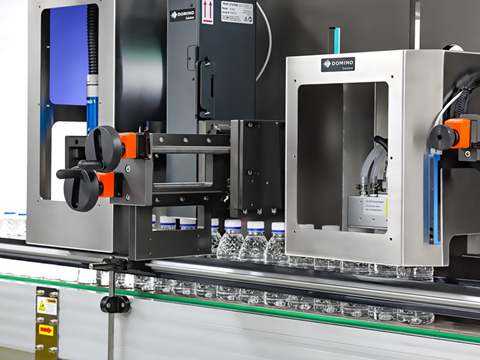
Domino Printing Sciences aims to support the transition into label-free beverage bottles with a range of Bottle Closure Printing Stations, designed to print variable data and machine-readable codes onto HDPE bottle caps and closures.
The company expects that negating the need for labels will simplify the process of recycling bottles and reduce the amount of plastic required overall.
“In the beverage industry, there is growing interest in labelless bottles and the role they can play in supporting the move towards a circular economy,” explains Nigel Allen, marketing manager 2D Codes & High-Resolution Inkjet, Domino. “Although plastic labels are often recyclable, they typically need to be removed prior to disposal to ensure that both labels and bottles can be recycled.”
Furthermore, manufacturers are expected to save up to 5% on production costs and lower the financial burden where plastic taxation applies.
Label-free beverage bottles are gaining traction, Domino observes, especially with the South Korean Ministry of Environment set to ban external labels on bottled water from January 2026.
“These new regulations pose a challenge for beverage manufacturers who need to adhere to product labelling requirements and communicate with their consumers and must find a way to do so without compromising production performance,” Allen continues. “With this challenge in mind, we worked with several leading Korean bottled water manufacturers to develop a solution for high-speed, in-line variable data printing on bottle closures.”
Variable data codes on bottle closures, especially QR codes, emerged as a solution – providing consumers with all the required data, like recycling information and product traceability, while also raising opportunities for further consumer engagement.
Domino’s range of Bottle Closure Printing Stations is apparently customizable to suit various production environments, including options for the near-line printing loose bottle caps and closures at high speeds, as well as in-line coding for filled bottles.
The in-line Bottle Closure Printing Station constitutes an advanced product handling system designed to stabilize filled water bottles; and Domino’s K300 monochrome digital printer, which reportedly facilitates high-resolution printing of 300-900dpi variable data codes at speeds of up to 44,000 bottles every hour.
Pre- and post-treatment are also provided to achieve adhesion and longevity in the printed codes. Additionally, integrated machine vision is expected to automate code inspection and verification.
One of Korea’s most prominent beverage manufacturers is said to have installed Domino’s first in-line Bottle Closure Printing Station, marking the first of its kind in the region – citing the complete, all-in-one nature of the solution as a factor in their decision.
“Following our success in South Korea, Domino is very pleased to be able to offer our new Bottle Closure Printing Station to the market,” adds David Bywater, Regional Development director – Asia, Domino. “We can see the trend for labelless bottles, alongside the need for variable data 2D codes including QR codes, becoming stronger and want to work with our customers to ensure that we can provide a solution that meets their needs.”
Various brands have sought to remove labels from their beverage bottles this year, including Sansu. Working alongside TotalEnergies Corbion, it produced a 100% Luminy PLA bioplastic bottle with an embossed label – aiming to streamline the recycling process by negating the need to remove extra packaging components.
Coca-Cola has also trialled the removal of labels from its Sprite and Sprite Zero bottles. While the existing labels are said to be fully recyclable, their removal was thought to lower the amount of packaging material required to manufacture them and, once again, save consumers from separating components at end-of-life.
If you liked this story, you might also enjoy:
How are the top brands progressing on packaging sustainability?
Sustainable Innovation Report 2024: Current trends and future priorities
Reuse vs. single use – which is better for the environment?
The ultimate guide to global plastic sustainability regulation







No comments yet